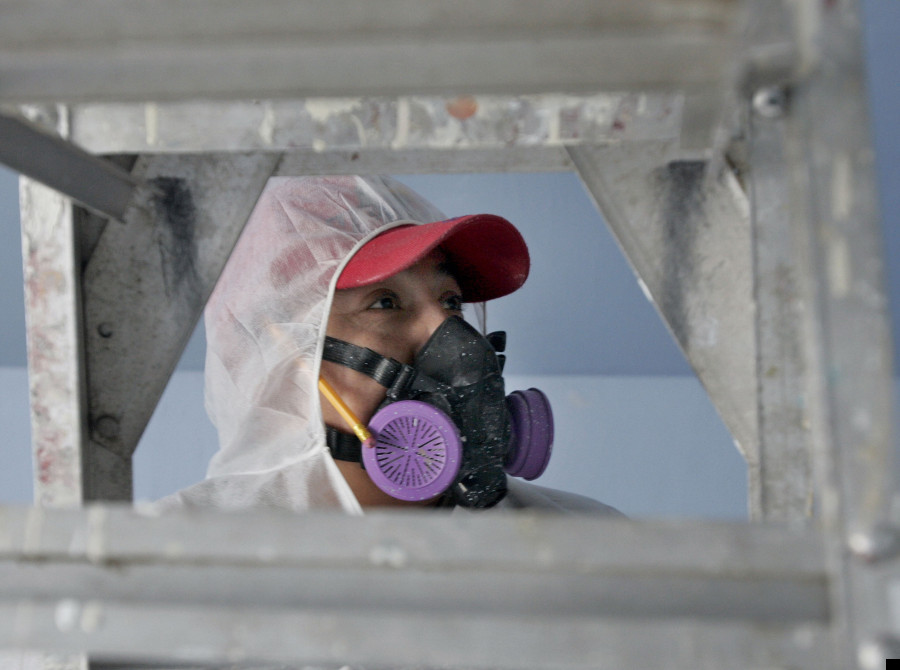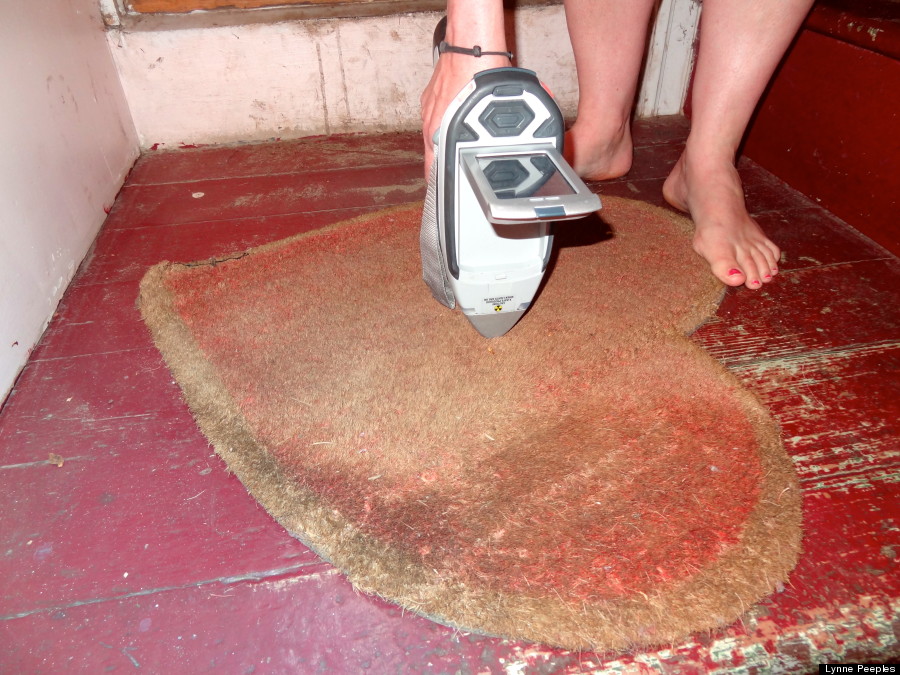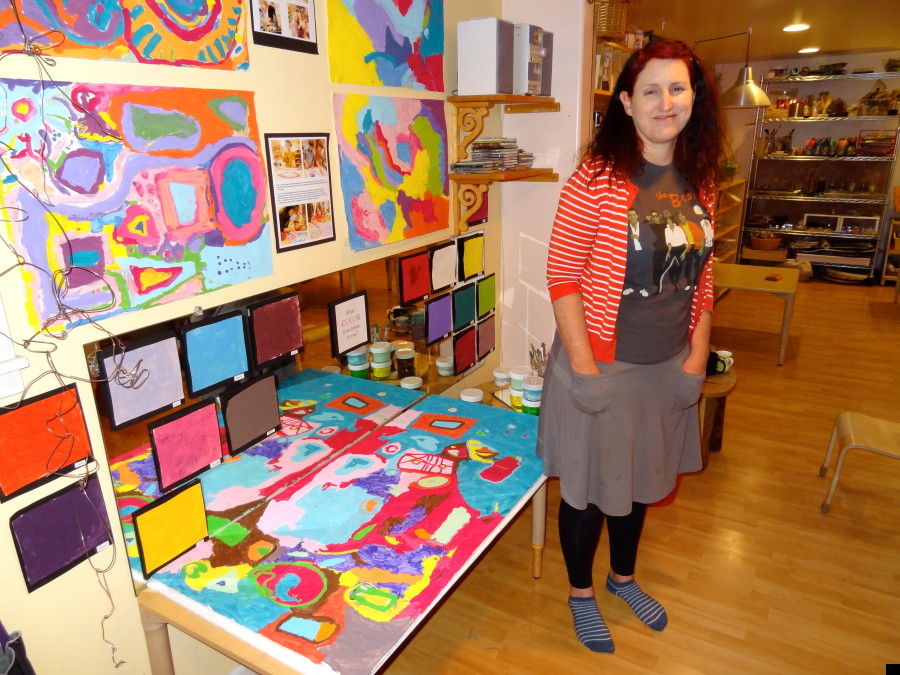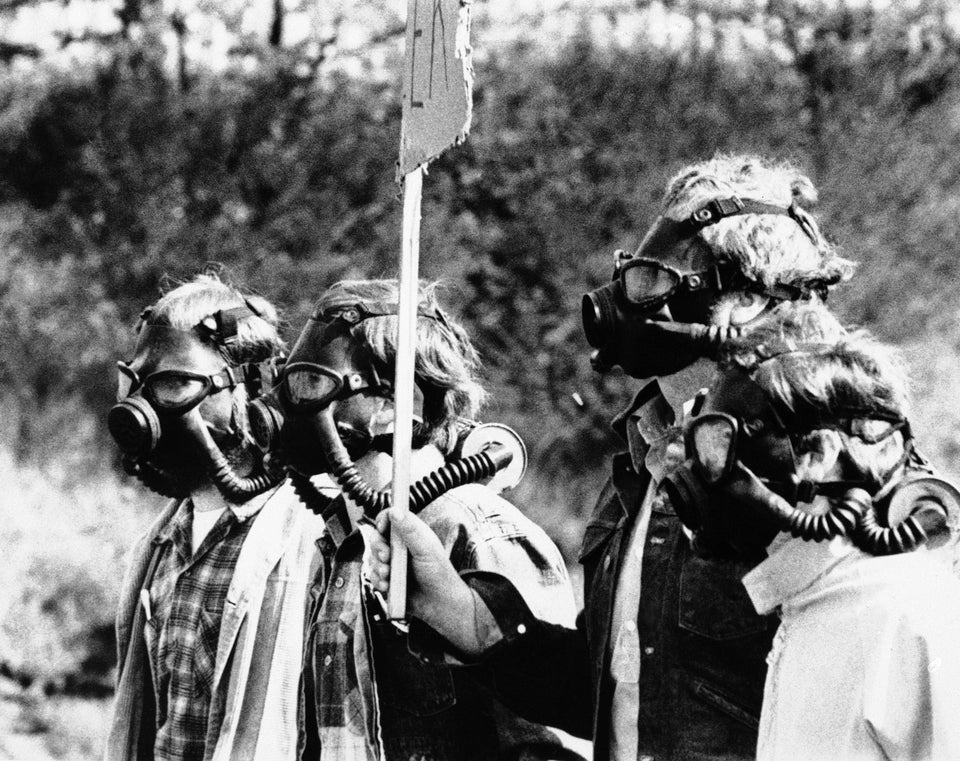
Portland, Ore. —
The worn, heart-shaped rug that greeted you upon entering Angela Molloy Murphy's preschool was a reflection of the love she has for the 17 children she cares for daily in her home's remodeled basement.
To Tamara Rubin, however, the welcome mat was more of a warning sign.
"You need to throw this out," Rubin told Murphy.
Rubin is executive director of the nonprofit Lead Safe America Foundation. On a visit to the preschool earlier this May, she pointed an X-ray fluorescence heavy-metal detector at the rug's faded red threads and relayed the bad news: It was loaded with lead.
Within the course of an hour, Murphy learned just how pervasive the toxic heavy metal was in her home and school: It was in the chips of lead paint on her deck steps, in dust rubbed free from door and window frames, in the glazes on her students' thrift-store mugs. The rug itself, Rubin suggested, was likely a reservoir for lead chips and dust tracked around on students' shoes.

Rubin had visited seven in-home preschools around Portland over the previous week. All held a lead hazard of some sort, she recalled, such as contaminated cups and toys. Lead paint was a concern in three of the schools. From Minnesota to New Orleans, similar issues have shown up at dozens of other daycares and preschools, as well as homes and elementary schools, that Rubin has been invited to test. She sums up the typical response: "I make women cry."
Shock and frustration flooded Murphy's face that day in May. She'd always made an effort to conserve the environment and protect children from toxins. Murphy uses natural cleansers and serves organic food to her students — generally the daughters and sons, she said, of "kombucha-making" Portland moms and dads.
"That's what we value," Murphy said, standing alongside a papier-mache tree in the center of her immaculate classroom, "but something like this can trump everything."

As students return to the classroom this fall, experts and advocates are warning of the overlooked health hazard plaguing daycares, preschools and elementary schools across the country.
Lead has been a popular paint additive for centuries. It speeds up drying and increases durability, as its makers once boasted in their marketing materials. But as a judge ruled in a high-profile case in California last December, lead paint manufacturers spent much of the 1900s deceiving the public with another claim: That their product was safe, even for young children, despite a long history of evidence suggesting otherwise. Ben Franklin wrote of lead's "mischievous" effects in 1786, and one lead-paint maker admitted in an internal company memo in 1900 that "any paint is poisonous in proportion to the percentage of lead contained in it."
The science remains clear that anyone can be affected by lead exposure, and that children under the age of 6 face the greatest risk. And as lead exposure is linked to a growing list of health conditions, researchers are finding that it takes less and less lead to put one at risk.
Structures built in the early to mid-20th century, during the heyday of lead-based paint, are most worrisome. Yet risks may reside in and around any building constructed (and painted) before 1978, when lead was finally banned from residential paint sold in the U.S.
France and other industrialized countries beat the U.S. to the regulatory move by decades, but many developing nations are still lagging behind. In fact, researchers recently found that most paint sold in the Asia-Pacific region — now the world's largest market for paint — contains large amounts of lead.
Here in the U.S., buildings have aged, and so too has the once-durable paint. The economic recession and constricted budgets have hastened lead paint's deterioration by contributing to lapses in upkeep of both public and private constructions. Portland Public Schools and older neighborhoods in Buffalo, New York; Baltimore; and Toledo, Ohio, are just a few places where neglect has manifested in lead hazards.
And while public awareness of environmental dangers such as lead has been on the rise in recent years, Rubin says, most parents still haven't considered hazards beyond their own homes.
Murphy's home was built in 1912. The average U.S. school's main building, much like the country's office buildings, is more than 40 years old, also pre-dating the ban.
Some older buildings may pose minimal risks, especially if they've been kept in good condition — with the paint still intact — or safely remodeled. But the extent of the risk is not always obvious. Lead dust can linger indefinitely, posing a threat even in the absence of peeling paint. The heavy metal can also lace soil around schools, due to accumulated lead paint dust and years of leaded gasoline emissions from cars and trucks. And old leaching pipes have been known to contaminate school drinking water.
"I've been to 50 cities in the last year. Hazards in schools are pretty universal," said Rubin, noting some exceptions include newer constructions in California, New Mexico and Arizona.
The federal government maintains there is little cause for concern. Because a national survey found that the average school-age child generally has "very low lead levels" in her blood, said Bernadette Burden, a spokeswoman for the U.S. Centers for Disease Control and Prevention, the CDC "has never focused much on this age group nor recommended that older schools be 'deleaded.'"
Outside of an EPA rule that requires lead-safe practices for any renovation, repair or painting of schools and other child-centered facilities — and a couple of states that require daycare centers to be lead-free to get a license — no federal regulations ensure that such facilities are tested for lead or made lead-free. Complicating matters, removing lead paint, when done incorrectly, can create more lead dust hazards — hence the need for lead-safe practices.
The Department of Housing and Urban Development could not identify any national agency that "deals with lead remediation for schools, daycares and other businesses," according to a spokesperson. The best the EPA offers is voluntary guidance for schools on preventing and mitigating some lead hazards, primarily related to drinking water.
Howard Mielke, an expert in lead poisoning at Tulane University School of Medicine, warns however that "there is no safe level of exposure." It's an assessment echoed by other leading experts, even the CDC.
A speck of lead dust equivalent in weight to a six-millionth of a packet of artificial sweetener, he noted, is enough to damage the developing brain and result in lower IQs, greater behavioral problems and higher crime rates. Young children's developing bodies are not only particularly sensitive to the heavy metal, Mielke said, but also more likely to be in close contact with it, given how much time they spend on the floor and their tendency to put their hands in their mouths.
"I can't think of a worse combination," added Mielke of children in contaminated daycare centers or preschools.
Asa Bradman, an environmental health expert at the University of California, Berkeley, discovered high levels of lead inside his daughter's daycare facility several years ago. Since then, he has investigated environmental hazards at 40 early education facilities across Northern California, and found lead dust present in 95 percent of them.
"This is something child care providers have to pay attention to," said Bradman.

One afternoon this spring, Virginia La Forte watched her 8-year-old son walk out the doors and down a ramp from Alameda School, a large elementary school in northeast Portland. His hand skimmed a worn handrail, she recalled, and a large chip of paint stuck to his palm.
Tests requested by parents, and subsequently ordered by the district, later confirmed that the paint flaking from the handrails was heavily leaded.
"That scared me. I spend all this money to make my house safe, yet I can't control the environment where he spends most of his days," said La Forte, who hired professionals to renovate her older home using lead-safe practices.
"To my knowledge, my kids have never had lead poisoning," she added, "but this is something for which you can't wait until there's a problem."
In response to initial complaints from La Forte and other parents, Portland Public Schools repainted the handrails at Alameda. But La Forte insisted more needed to be done. "The school is covered in poison," she told The Huffington Post in May.
La Forte invited Rubin and her $40,000 XRF detector to Alameda — the day after Murphy learned of her hazards. The two women walked the exterior of the century-old school, La Forte pointing out the pale yellow paint withering and cracking on the surface.
"It looks like it's blistering," La Forte said.
Just as La Forte feared, the entryway, the window frame of the first-grade classroom, even patches of grass alongside the building — all tested positive for lead, at levels several-fold greater than federal thresholds for "lead contamination."
"This is criminal. Yet there's no law against it," said Rubin, adding that she hasn't witnessed the same degree of outcry among parents outside of Portland. "People just don't know. The hazard is invisible."
It's not only young children who are at risk, either.
"We have to remind people that it doesn't stop at age 6," said Ruth Ann Norton, executive director of the nonprofit Coalition to End Childhood Lead Poisoning. "Older kids are still at risk. So are you and I."
Research suggests that lead exposures later in life, and the release into the blood of lead stored in bones from earlier exposures, may play a role in health issues including cognitive decline, reproductive disorders, heart disease and kidney problems. A recent study at the University of Michigan even found that offspring of pregnant mice exposed to minute amounts of lead had an increased risk of becoming obese.
Louisiana state Sen. J.P. Morrell (D-New Orleans) has sponsored bills to address lead contamination at daycares, preschools and elementary schools in his home state. His city, New Orleans, is among the most notorious for lead paint hazards. Morrell expressed frustration with the slow progress on the issue in an interview with Rubin for her forthcoming documentary, "MisLEAD: America's Secret Epidemic."
"There's never been really an effort to try and say, 'Well, let's go test that school you've been having kids in for 70 years,'" he says in the documentary. "That's really where I've seen some of the friction from those older schools, who have no intention whatsoever of doing any remediation. In their opinion, if no kid's fallen off and, you know, died, then nothing's probably wrong."
Hazards at some schools, like those at Portland's Irvington School, may be particularly easy to overlook. Because the school is made of bricks, the presence of paint, whatever its content or condition, is not immediately obvious. Irvington was another one of Rubin's stops in May.
"When you look at a brick building, you may not see a problem," said Rubin, "but then you zoom in."
Standing at the side of the school's main building, she pointed her finger at some broken glass on the pavement. "This is going to cut someone's foot," she said. Rubin then pointed to flaking paint on the trim of a window a few feet away, which her XRF had just determined was loaded with lead: "That's going to cause brain damage."

Shortly after Rubin pulled away from Murphy's house in her red Volkswagen — her bad-news machine in the trunk — the preschool teacher said she went about clearing up what lead hazards she could. She tossed out the contaminated rug and some tainted Mardi Gras beads. Since it was the end of the school year, she also sent her students home with their mugs, and a warning for their parents: If your child's mug has a red "X" on the bottom, she told them, throw it out.
"There are objects, probably in every classroom and in every home, that have lead, and parents just don't know," Murphy said.
She has since purchased a set of antique glasses that tested clear for lead, and a new, large floral rug now lies in the school's entryway. It's neither red nor heart-shaped, but it is lead-free and washable.

After the testing at Alameda, La Forte continued to pressure Portland Public Schools to take further action. She collected and sent some 50 letters from concerned parents to the district. In August, the effort appeared to pay off: La Forte walked by her son's school and saw workers repainting the entire exterior.
During a conversation with HuffPost in May, Christine Miles, a spokeswoman with Portland Public Schools, acknowledged the concerns at Alameda and other facilities in the district. "We have old buildings," said Miles, noting many of the district's facilities were built in the 1950s, and some as far back as the 1920s. "We do have some lead paint."
"We have to slowly make changes when we can afford them," she added. Miles lamented the budget cuts inflicted on the district: "It's very expensive. We also want to keep teachers in the classroom."
The problem looks much the same at the national level. Again, no agency is in charge, and funding for childhood lead poisoning prevention has suffered cutbacks in recent years. In 2012, Congress cut the CDC's lead budget by more than 90 percent. It has since rebounded to $15 million, which is still about half of its pre-2012 allotment.
"The sad thing is, there is really no one officially responsible for the environmental health and well-being of children in our schools," said Nsedu Obot Witherspoon, executive director for the Children's Environmental Health Network, which runs the national Eco-Healthy Child Care Program to train and educate daycare workers in environmentally healthy practices. "A lot of this comes down to money. Lead remediation is not cheap in an old school building." The price tag can run tens of thousands of dollars for a school, if not more, based on EPA estimates of $8 to $15 per square foot.
La Forte said she was "thrilled" that her school district appeared to be addressing parents' concerns. Miles, however, suggested in August that the wet-scraping of old paint and repainting that La Forte witnessed was "standard procedure," and more about giving the building an overdue "facelift" than removing lead. Still, Miles said, it was "fantastic" that the district could "take care of two issues at the same time."
Good news recently surprised Murphy, too. In late July, she learned that the City of Portland had accepted a grant application to cover up to $10,000 in costs associated with cleaning up any lingering lead hazards in her home and school. Portland still has a couple hundred grants to allocate over the next two years, and Murphy hopes other home-based programs will apply.
Richard Sassara, Portland's Housing Lead Grant Coordinator, told HuffPost in May (before Murphy's application was accepted) that it would be an added bonus if the city could clean up in-home daycare facilities.
"We could help a lot of children at one time," said Sassara. "That's a niche I don't believe we've accessed before."
The city's lead-abatement funding comes from HUD, which allocates about 200 grants to local governments around the country to assist in the clean-up of qualified low-income residences. However, given the restrictions on how the money can be used, the handful of facility-based daycares that have applied for Portland's grants did not qualify.
And experts see the lack of financial assistance for such facilities as another critical hole to fill.
Witherspoon's group is among the advocates highlighting — in research papers and through outreach efforts — the need for state and federal legislation to help clean up lead hazards in daycare centers and schools. Several related federal bills were proposed with the same goal in the 1990s and 2000s. One sponsored by then-Sen. Barack Obama (D-Ill.), for example, called for the assessment and reduction of lead in "child-occupied facilities."
All the proposals failed.
The failure to fully address lead hazards, whether in a home, daycare or school, is short-sighted, advocates and experts argue.
"At the extreme, lead exposure means special education, or even criminal behavior, later in life. Those are societal problems, and they are costly," said Tulane's Mielke, whose research helped phase lead out of gasoline in the 1970s. He credits the drop in violent crime over recent decades at least in part to that public health milestone. More recently, he spearheaded a HUD-funded project that cleaned up lingering lead from playgrounds at 25 New Orleans childcare centers. The price tag for remediation of the soil at the average center, he said, came to only about $4,000.
Each dollar invested in lead paint hazard control results in a return of $17 to $221, according to the U.S. Economic Policy Institute, a nonprofit think tank focused on labor issues.
Tracy Swinburn, a researcher at the University of Michigan Risk Science Center, published a study in June that calculated lead poisoning costs in Michigan alone to be about $330 million each year. Her team took into account increases in health care, crime and special education, as well as declines in lifetime earnings — all well-documented impacts of lead exposure.
"If you can invest in lead abatement, it starts to become worthwhile pretty quickly," she said. "Public places that seem to be affecting a lot of young people at once seem like a good place to start."
It can also be a gift that keeps on giving. "Now, whoever owns this house after us will be safe," said Murphy.
